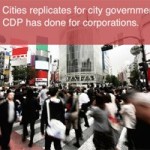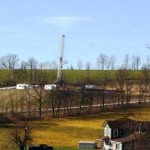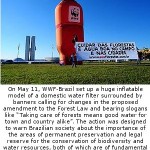- The results indicate that sympodial bamboo in the tropics is likely to sequester equal or more carbon than Eucalypt plantations. The review of the data calculated and collected from the literature also has clearly shown that more carbon is likely to be sequestered by species growing in tropical areas (both bamboo and trees), than by species growing in sub-tropical areas.
A literature review indicated that the carbon stock in vegetation (including understory species and other mixed vegetation) of Moso bamboo is within the range of 27-77 t C/ha. The majority of carbon appears to be sequestered in the arbour layer accounting for 84-99%; the shrub layer and the herbaceous layer accounted for very small contributions, especially in intensively managed bamboo forests. When looking at the whole ecosystem, including the soil, Moso bamboo forest ecosystem carbon storage capacity was reported to be between 102 t C/ha and 289 t C/ha, of which 19-33% was stored within the bamboo culms and vegetative layer and 67-81% stored within the soil layer (rhizomes, roots and soil carbon). This indicates that the soil layer carbon content is likely to be about 2-4 times greater than the vegetative layer. Bamboo ecosystems were found to have an equal or somewhat lower carbon stock (between 102- 288 t C/ha) when compared with other forest types (between 122 – 337 t C/ha). The total carbon stock in bamboo forests is obviously affected by climatic factors. The carbon stock of bamboo in Fujian province (Qi, 2009), where the climate is more suitable for bamboo growth than in Zhejiang province (Zhou, 2004), surpassed Pinus elliottii in its 19th year, Chinese Fir in its 15th year, and showed comparable carbon stock to broad-leaved forest (262.5 t C/ha) and tropical forest (230.4 t C/ha).
At the national level in China, the carbon stock in bamboo forests has been estimated by combining carbon density data with inventory data on bamboo resources in China. The results varied greatly between different studies. The total carbon stock in bamboo forests in China was estimated between 605.5 – 837.9 Tg C and carbon density for bamboo between 130.4 -173.0 t C/ha.
The effects of management regimes on carbon storage were also studied. Intensive management of Moso bamboo seems to be able to increase the carbon storage capacity in above ground biomass. It was also noted that the carbon in rhizomes, roots and soil may be lower under intensive management. The role of management practices on carbon sequestration by bamboos needs further study.
As with other forest products, bamboo products retain their carbon content until they either biologically deteriorate or are burnt. Although bamboo has many advantageous features over many timber species such as high tensile strength, flexibility and hardness, it is argued that bamboo products are not as durable as many wood based products, therefore having a shorter life cycle. However, this appears to be more due to customs than to technical limitations, and in recent years many more durable bamboo products have entered the market. This investment in producing more high quality, durable bamboo products needs to continue, because it is a key issue in order to optimize and prolong carbon storage. Prolonged storage of carbon is only possible when the culms are processed into durable products with long lifecycles, such as construction materials, panel products and furniture.
An alternative is to utilize bamboo as a bio-energy resource as an alternative for fossil fuel, or for charcoal products, including biochar. The promotion and development of bamboo management and utilization for such purposes could provide additional opportunities to mitigate climate change.
In conclusion, within this comparative analysis considering Eucalypt and Chinese Fir, rapid growing trees from tropical and subtropical regions respectively, bamboo plantations seemed to be highly comparable to fast-growing trees. Moreover, the benefits appear to extend to the ecosystem and regional level due to bamboo’s carbon sequestration capacity, stemming from its re-growth capacity and annual harvesting regimes. Sustainable management and appropriate utilization of bamboo resources can increase the amount of carbon sequestered, through management changes which increase storage capacity within the ecosystem in the short-term, and through transformation of carbon into durable products in the long-term. Bamboo is managed and utilized by hundreds of millions of people globally, who rely on it for many different uses, from household uses and protection of riverbanks to being a source of income. Many bamboo farmers live in less developed regions and are affected by poverty. The promotion of bamboo as a sustainable carbon sequestration tool will not only create new opportunities for mitigating climate change but can improve and protect millions of rural livelihoods through investment in sustainable bamboo management, industry and technology.
Original Study:
Title of the Study: “Bamboo and Climate Change Mitigation: A Comparative Analysis of Carbon Sequestration”
Authors: Lou Yiping, Li Yanxia, Kathleen Buckingham, Giles Henley, Zhou Guomo
Published by INBAR in 2010.
Click here to read Full Study:
http://www.inbar.int/publication/pubdetail.asp?publicid=232
Notes:
[1] Professor John Schellnhuber, Institute for Climate Impact Research, Potsdam, Germany.
[2] This report approaches the question of climate change mitigation by looking at the rate carbon sequestration and carbon storage in the bamboo ecosystems, as determined by growth models. It does not address rates of removal of carbon dioxide from the atmosphere directly, or the flux in carbon dioxide within the bamboo ecosystem. It focuses rather on carbon sequestration based upon volumes of carbon stored in bamboo over its growth period, and compares the effects of different management practices on this process. This is the only area which has been researched in detail for bamboo to date, although it is hoped that this work can be built upon to look at the other aspects of carbon dynamics in the bamboo ecosystems.
About INBAR
The International Network for Bamboo and Rattan (INBAR) is an intergovernmental organization dedicated to reducing poverty, conserving the environment and creating fairer trade using bamboo and rattan. INBAR was established in 1997 and represents a growing number of member countries all over the world. INBAR’s headquarters are in China and there are regional offices in Ghana, Ethiopia, India and Ecuador. INBAR connects a global network of governmental, non-governmental, corporate and community partners in over 50 countries. For more information, visit www.inbar.int.













